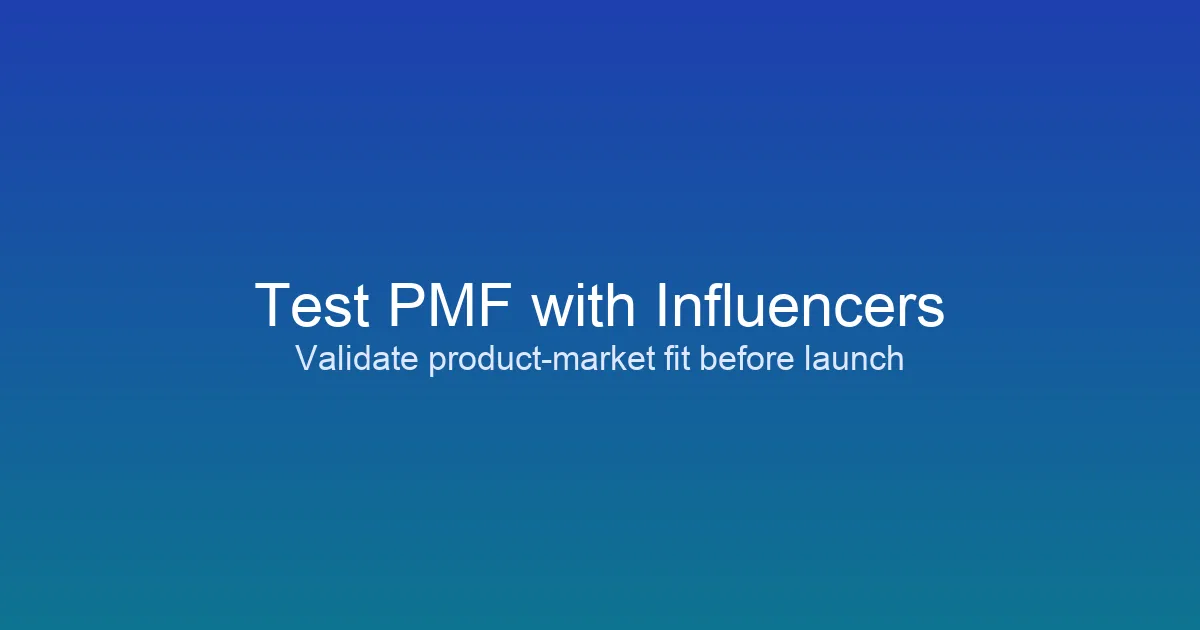
How to Use Influencers to Test Product-Market Fit Before a Full Launch
How to Use Influencers to Test Product-Market Fit Before a Full Launch
Launching without validation is a bet most AI, SaaS, and D2C founders can’t afford. The fastest way to hear if you’ve hit product-market fit is to put the product in the hands of people who already shape conversations in your niche. Influencers don’t just amplify messaging—they stress-test onboarding, pricing, and positioning in public. Here’s how to transform influencer marketing into a PMF lab.
Why Influencers Belong in Your PMF Toolkit
- Built-in focus groups: Niche creators interact with your exact buyer persona every day, so feedback arrives with context.
- High-signal feedback loops: Social comments, DMs, and share rates reveal friction points faster than traditional surveys.
- Cost-effective validation: Compared with paid ads or large beta programs, influencer pilots deliver actionable data with minimal spend.
- Social proof on day one: Even negative feedback helps you iterate in public, signaling transparency and building trust.
Step-by-Step: Running an Influencer PMF Sprint
- Frame the hypothesis. Define what you need to validate—onboarding clarity, feature adoption, or willingness to pay.
- Build a persona matrix. Map 3–4 buyer personas, then source nano and micro influencers whose audiences mirror each segment.
- Co-create the brief. Provide a single-line hook, success metrics, and the exact actions you want their followers to take.
- Ship early access. Give creators sandbox accounts, TestFlight links, or exclusive SKUs so they can share first-hand experiences.
- Instrument everything. Track ReplyRate, AcceptRate, and post-level engagement alongside product telemetry (activation, retention).
- Host debriefs. Within 48 hours of post go-live, schedule debrief calls or async forms to capture qualitative insights.
- Iterate and relaunch. Roll improvements into a V2 drop with the same creators to confirm that friction points are resolved.
Key Signals That PMF Is Emerging
| Indicator | What to Watch | Why It Matters |
|---|---|---|
| Repeat usage | Activation → Day 7 retention among influencer referrals | Shows the product delivers recurring value |
| Qualitative pull | Comments asking for pricing, access codes, or regional availability | Indicates latent demand beyond the pilot cohort |
| Organic sharing | Reposts, stitches, or community-generated how-to threads | Expands reach without extra spend |
| Pricing feedback | Followers asking about tiers or bundling options | Validates willingness to pay and packaging |
| Referral velocity | Creators agree to second campaigns or become affiliates | Confirms the partnership feels authentic and profitable |
Advanced Tactics for Influencer-Led Validation
- Segmented testing: Assign different feature sets or onboarding flows to specific creator cohorts to see which variation wins.
- Iterative release cycles: Treat each wave as a sprint; ship fixes within 7–10 days and invite the same creators to retest.
- Cross-platform triangulation: Mix Instagram reels for top-of-funnel buzz with YouTube walkthroughs and LinkedIn thought leadership for B2B validation.
- Closed-loop analytics: Combine CrowdCore campaign data with product analytics so you can attribute activation, retention, and revenue back to creator cohorts.
Tool Stack Checklist
- Influencer CRM: Manage outreach, briefing, and deliverables in CrowdCore to keep every message coordinated.
- Feedback hub: Centralize qualitative notes with tools like Notion or Coda so product and marketing teams iterate together.
- Product analytics: Use Mixpanel, PostHog, or Amplitude to track activation and retention for influencer-sourced cohorts.
- Survey automation: Layer Typeform or Airtable forms to capture structured post-campaign feedback from creators and their communities.
Metrics to Report Internally
- Activation Rate: Percentage of referred users who complete your “aha” action within 48 hours.
- Feature Adoption: Which modules or use cases see the highest repeat usage after creator walkthroughs.
- Cost per Insight: Total campaign spend divided by the number of actionable improvements shipped.
- Payback Period: Time to recover influencer spend through attributed revenue or pipeline.
- Net Sentiment: Ratio of positive to negative social mentions across posts and comments.
Common Pitfalls (and How to Avoid Them)
- Too much script, not enough authenticity: Encourage creators to share raw reactions; scripted reads hide the real friction.
- Ignoring negative comments: Treat criticism as a backlog—log, prioritize, and report back to creators when fixes ship.
- One-and-done launches: PMF rarely happens on the first try; plan for at least two iterations before judging success.
- No incentive alignment: Pair monetary compensation with perks like early feature access or revenue share to keep creators invested.
Regional Playbook
- North America: Side-by-side tests with GTM, RevOps, or e-commerce creators uncover pricing sensitivities and compliance questions early.
- Europe (EMEA): Local-language nanos in Germany or France help validate messaging in regulated industries before deploying UK-based micro influencers for scale.
- APAC: Prioritize community-driven platforms (LINE, Telegram, WhatsApp) and partner with creators who can localize onboarding for regional payment flows.
- Latin America: Blend WhatsApp-first nano cohorts for qualitative insights with bilingual micro influencers who can connect São Paulo, Mexico City, and Miami ecosystems.
Bring PMF Testing Into Your Launch Rhythm
When influencer campaigns become part of your product development cycle, you launch with evidence—not optimism. Turn CrowdCore into your PMF control center to source the right creators, orchestrate outreach, and translate every post into measurable product decisions. The next feature drop doesn’t have to be a gamble. Let the voices your buyers already trust guide the roadmap.